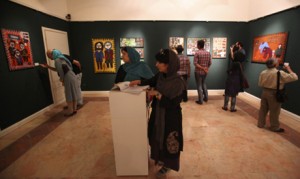[caption id="attachment_39077" align="alignright" width="210"] Iranians visit an art gallery in Tehran, Iran, 1 July 2013[/caption]
Iranians visit an art gallery in Tehran, Iran, 1 July 2013[/caption]
Despite an ailing economy, the Iranian capital was able to dazzle the global art world at its second auction of the year, where 80 works sold for $2 million
Some arrived in Porsches or BMWs, which were whisked away by valet parking attendants. The hotel lobby was awash with the celebrated and powerful including A-list actors, well-known artists and captains of commerce.
For one glimmering moment late last month, the Iranian capital was the talk of the world's art market after 80 works sold for $2 million, astonishing a country whose economy is battered by Western sanctions but still has pockets of wealth looking for investment havens for their money.
This is the other side to Tehran hidden by walls surrounding elite enclaves or in high-rise towers with doormen that has more in common with well-heeled spots in Manhattan or London.
Many in the gilded set of Tehran come from old merchant families. Others made it big in newer ventures: the export trade with the Gulf or the city's still-hot real estate market, where prime residential property prices in the overcrowded capital can reach Tokyo-level rates of $10,000 per square meter, or $929 per square foot.
Signs of wealth still appear in Tehran even as sanctions bite deeper over the country's nuclear program.
Car dealers get orders even at inflated price tags because of import complications for a $300,000 Mercedes Benz or BMWs at $200,000 each. Ice cream flaked with edible gold dust was a signature dish at the rotating restaurant atop Tehran's 435-meter (1,427-foot) Milad Tower. Officials chagrined by the extravagance banned the dessert in 2011, as tightening sanctions have led to shortages of medicine and protests over the soaring price of chicken.
Iran's stumbling economy has become such a political issue that it dominated debates before June's presidential election. The winner, Hasan Rouhani, has pledged to try to reverse painful inflation now running at about 30 percent and work to ease sanctions.
The art auction Tehran's second such event in the past year offered a rare window into the investment strategies of the city's rich, whose route to acquire assets overseas has been complicated by sanctions that bumped Iran from main international banking networks. Now some of Iran's wealth increasingly appears drawn to the rising profile and prices of Iranian art in galleries from Dubai to Los Angeles. In April, the painting "The Secret Garden" by Iranian artist Farhad Moshiri brought the highest price at a Christie's auction in Dubai at $987,750.
"They have learned that artworks have business and investment aspects while also having a high cultural and social prestige," said Saeed Leilaz, a prominent economic analyst in Tehran.
Iran's ruling clerics who once even banned music in the years after the 1979 Islamic Revolution now encourage Iran's vast artistic community that includes such luminaries as Oscar-winning director Asghar Farhadi. But there are limits. Strict bans are in place on anything that hints too strongly of political dissent or criticism of the theocracy.
Other artists have faced prosecution for alleged support of opposition movements. This month Iranian director Jafar Panahi appeared via Skype at the Karlovy Vary Film Festival in the Czech Republic after the screening of his film, "Closed Curtain," which he made in defiance of censors while under house arrest. Authorities imposed a 20-year filmmaking ban on Panahi in 2010 after his conviction on charges of "making propaganda" against Iran's ruling system.
The works on the auction block at Tehran's high-end Azadi Hotel the former Hyatt near the infamous Evin Prison played it safe, however. The collection, such as the 1970 painting "The Body of Trees," avoided any political overtones.
That piece, by the late painter and poet Sohrab Sepeheri, brought the highest price of the auction, about $220,000. The buyer, the private Pasargad Bank, already has bought more than 140 artworks in recent years as part of plans for a museum.
A photo entitled "Weeping Cow," by the internationally renowned film director Abbas Kiarostami, fetched $22,000 when the gavel came down. It was wielded by celebrity auctioneer Reza Kianian, a veteran film and television actor who has won the Iranian equivalent of an Academy Award.
"I did not expect that all works could be sold," Kianian said. "The excitement was very high, and that pushed me to raise the offers."
A photo by Jamshid Bayrami on the hajj, or Islamic pilgrimage to Saudi Arabia, was sold for about $6,000. Bayrami's works have been sold previously at Sotheby's auctions in London and Qatar.
"Many know that investment cannot be limited to real estate, gold and carpets," the photographer said. "It also shows the strength of Iranian art lovers and artists."
The manager of the auction, Ali Reza Samei Azar, said he had hoped to top last year's auction that brought in $1.3 million, but the sinking economy initially made him think they "were dreaming."
"We rarely see the sale of 100 percent of artworks in international auctions," Samei Azar gushed after the 3 1/2-hour event on June 28. "Iranian society has shown that art can be an investment."
He described many of the buyers as "young and Western educated."
"It was exciting," Samei Azar said. "One-third of buyers were new buyers. It shows the growth potential for Iran's art market."
By Ahram Online
The Iran Project is not responsible for the content of quoted articles.

 QR code
QR code